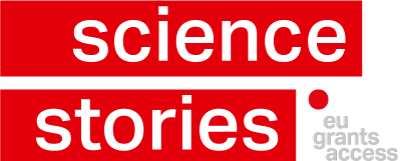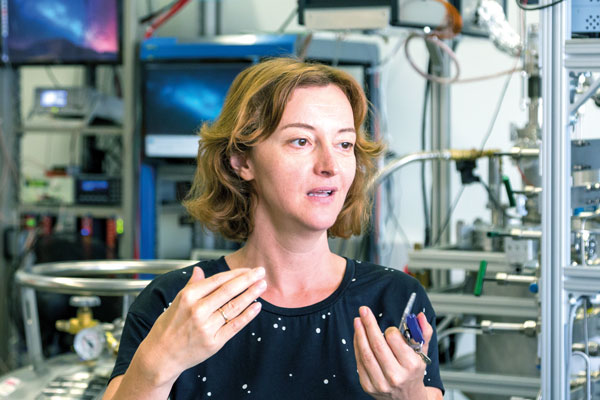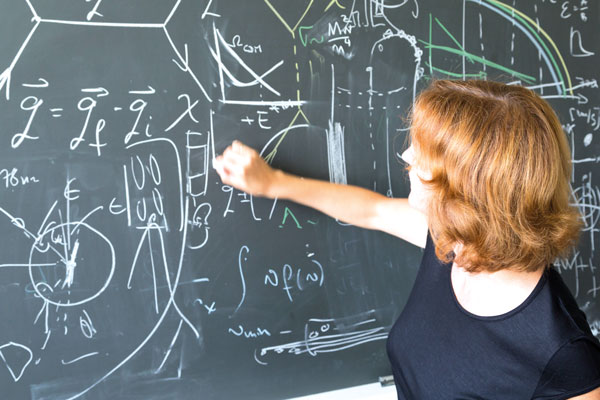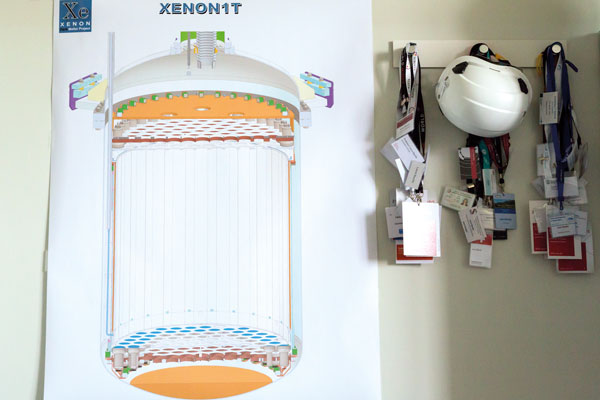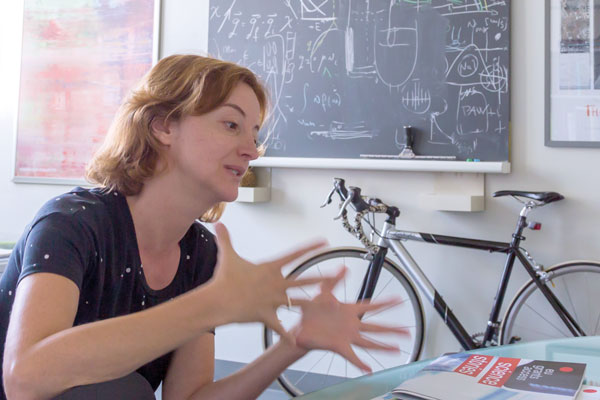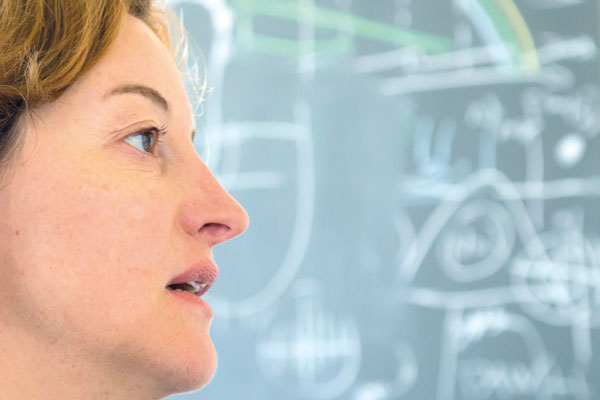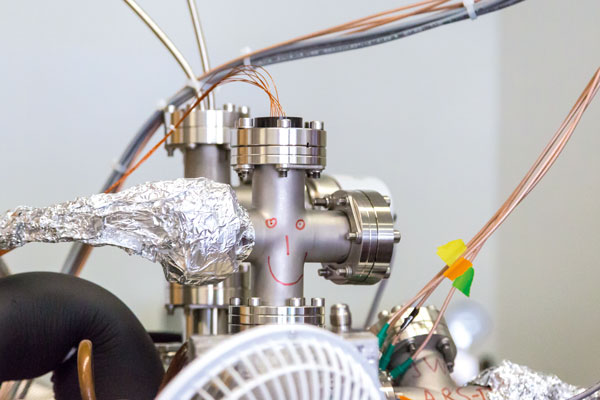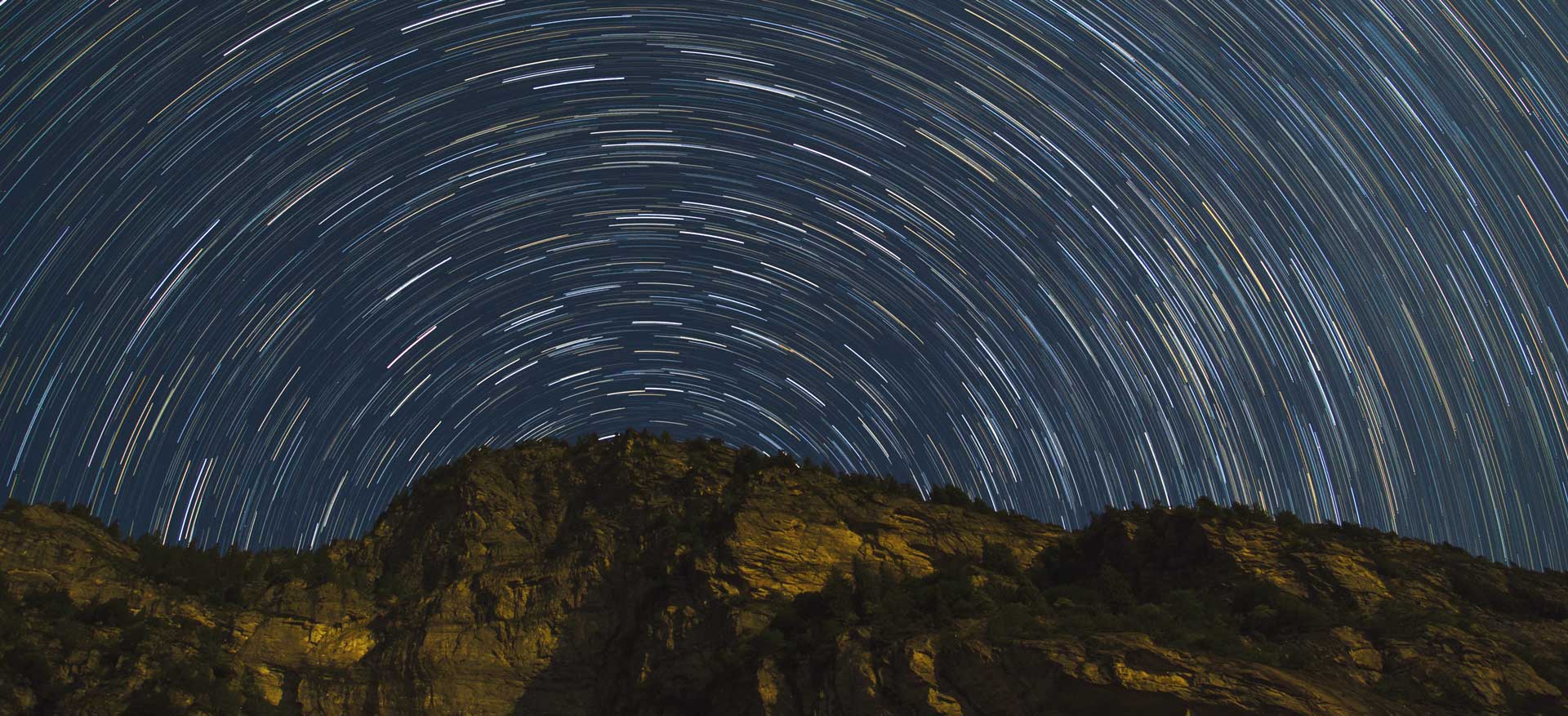
Enlightening the dark
Searching for cosmic weaklings
Why Laura Baudis is searching for cosmic weaklings and why these invisible particles might answer the question of whatever holds the world together in its inmost folds.
Her racing bike is leant against the office wall, a construction site helmet is placed on the shelve, and the blackboard is scribbled over completely with formulas. These three items perfectly symbolise the professional life of Laura Baudis. The 47-year-old Professor of Physics at the University of Zurich rides her bike to work because it gets her there twice as fast as the tram would. Time is precious, most people do not have enough of it, she says. Yet, she deals with a stretch of time that is virtually inconceivable for us human beings. The researcher looks back on 14 billion years – all the way to the beginnings of space, time and matter. She is devoted to finding the answer to a mystery that has always been on the minds of humankind. “I wish to find out how the universe was formed and what it is composed of,” she says. Alike Goethe’s Faust, she is interested in «whatever holds together the world in its inmost folds». Specifically, she is interested in dark matter, that mysterious part of the world that cannot be revealed by any high-tech telescope.
Fascinated by the invisible
Today, dark matter is a popular topic. However, back when the native Romanian completed her thesis on dark matter at the Heidelberg University 20 years ago, she was given a fatherly advice by one of the professors: “You’ve had your fun with the dark matter – now on to some real physics.” The «real physics» would be the traditional particle physics, dealing with the composition of the visible matter and forces holding it together. Yet, the invisible had already cast its spell over the young researcher; today, the professor is still just as fascinated by dark matter as she had been as a student. «Enlightening the dark» is the title of her project Xenon-1T.
Xenon-1T is the detector located within the Gran Sasso, an Italian mountain massif, deep down below 1,400 meters of rock, so that it is protected against disturbing cosmic radiation. The Latin word detector means revelation. Baudis and her team rely on the xenon detector to reveal those particles that they presume to be a part of the dark matter. Observations suggest that the matter known to us (and of which for example the stars, the Milky Way and other galaxies are composed) represent merely roughly 15 percent of the total matter within the universe. Therefore, the other 85 percent must be made of a different, non-luminous substance.
Searching for WIMPs
Already 84 years ago, the Swiss astrophysicist Fritz Zwicky analysed the mass of the galactic clusters and concluded that the gravitational force alone cannot hold them together. There must be an additional bonding force. Zwicky assumed a large amount of matter running through the galactic clusters and called it «dark matter». “However, we still do not know what it is made of,” Baudis regrets. One theory is that it is composed of heavy, neutral particles, interacting only weakly with the matter known to us. Physicists call these particles «weakly interacting massive particles», or, in short, simply «WIMPs». A wimp is also another word for weakling. The specialists assume that these particles operate in absolute concealment and neither emit nor absorb light.
However, were the WIMPs to collide with other particles – according to the assumption – energy would be released, causing a brief flash of light. Baudis and her team are trying to catch such collisions by means of their detector in the Gran Sasso underground laboratory. The Xenon-1T detector consists of a tank filled with about three tons of liquid xenon, an inert gas with large atoms. 248 light sensors are attached to the bottom and top part of the cylindrical tank in order to detect the collisions. Nevertheless, such impacts are rare. So far, no WIMPs have been found – but at this point, there are other priorities. For now, the team’s main concern is to have a highly light-sensitive detector. According to Baudis, first results have shown that the Xenon-1T is the most sensitive instrument worldwide in search of dark matter today.
Detector with 50 tons of xenon
The formulas on Laura Baudis’ blackboard deal with her next Xenon project. The researcher, who is “fascinated by the clarity and simplicity of physical laws”, is in the middle of the design phase for an even larger detector by the name of Xenon-nT. Compared to its predecessor, this detector shall impound about three times the amount of liquid xenon and have twice as many light sensors. The team plans to start building the detector in 2018; the project itself will start the year after. What is more, even the project after the Xenon-nT is already in the pipeline. It is called Darwin, which is an abbreviation for «dark matter wimp search with liquid xenon». The Darwin detector, which shall impound 50 tons of xenon and thus 16 times more of the inert gas than the current detector, is supposed to be put into operation by about the year 2025. For the pre-project to Darwin, Xenoscope, Baudis received one of the highly coveted ERC Advanced Grants this year (see box).
«We are looking at an area of
the universe that no one has ever looked at before.»
Laura Baudis’ parents seem to have handed down their enthusiasm for mathematics. Though both of them earned their PhD in literature, they have always loved mathematics and have encouraged their daughter’s talent from the very beginning. At the time when Baudis discovered her interest for the dark matter, only a few others were conducting research in that area. The majority of the physicists were dealing with «real physics». “Because our group was so small at the time, we had to collaborate closely, as we continuously had to develop the entire technology for our experiments all by ourselves,” Baudis explains. This has not changed over the years. Although by now thousands of researchers all over the world are dealing with dark matter, the many close collaborations have not stopped: For example, the Xenon project consists of an international collaboration of 150 scientists from Europe, Israel and the United States. They all contribute to the construction and operation of the detector as well as the data analysis. The members of this collaboration themselves have to develop and construct the entire technology, the electronic system and the light sensors with which they wish to analyse the composition of dark matter.
EU Programmes allow close collaboration with industrial partners
This is why the European funding programmes are so valuable, for example those of the Framework Programme Horizon 2020. Two of the projects carried out by Baudis and her team are embedded in the Marie Skłodowska-Curie Actions, namely in an ITN and a RISE funding programme. ITN is short for Innovative Training Network, RISE stands for Research and Innovation Staff Exchange. Both projects started last year and deal with cooperation, exchange and networking. RISE focuses on visits and networking between researchers of all hierarchical levels. Baudis, who conducts experimental physics, hereby especially enjoys the exchange with physicists focusing on the theoretical aspects of the field. “These interactions can be mutually beneficial,” she says. Both fields of physics are dependent on each other.
The focus of the ITN programme is on the promotion of young talent: During a quarter of a year, PhD students benefit from collaborating with other research groups or industrial partners. “I hereby win additional PhD students and commitment for my projects. In addition, my students have the opportunity to gain new experiences elsewhere,” Baudis says. For example, one of her PhD students will join the Japanese Hamamatsu company for a three-month collaboration; this enterprise produces the light sensors for the xenon detectors inside the Gran Sasso laboratory. The sensors are custom-built devices, as they have to be as sensitive as possible. Baudis and her team develop the light sensors together with the manufacturing company. Currently, they are refining the idea of silicon sensors the size of a fingernail. Also in terms of technology, the team enters uncharted territory. So they publish papers dealing exclusively with the technical details of the detector and light sensors, which in turn are then exchanged and discussed among scientists. “This is why it is extremely helpful for us that our PhD student can be on site at Hamamatsu thanks to the ITN funding programme,” Laura Baudis states. Important questions can thereby be addressed directly with the manufacturer and the student will have gathered new knowledge upon her return. Besides, the physics professor feels very strongly about promoting young talents. According to her, “it is a very beautiful task to collaborate with young people, to see their enthusiasm and to encourage their endeavours.” Baudis supervises six PhD students as well as five postdocs. Once, a high school student joined Baudis’ team during her summer holidays, as she intended to write her graduation diploma paper on dark matter. Currently, a 70-year-old bachelor student completes the team; he was sent to the Gran Sasso laboratory recently in order to test materials.
The Gran Sasso laboratory is her home away from home
The construction site helmet sitting on Laura Baudis’ office shelve is needed to move around inside her spacious underground laboratory. The mountain massif is located about 150 kilometres east of Rome near L’Aquila. Here, she spends a great amount of time, especially when a new detector is set up. She laughs when calling the underground laboratory, which is one of the largest and deepest in the world, her “home away from home”, as she had participated in smaller projects there already as a student. The Gran Sasso, the Big Rock, serves as a protective shield against disturbing cosmic rays. Inside the mountain, there are several gigantic research halls with additional experimental sites. Laura Baudis has taken her children down to the «cave of wonders». Unsurprisingly, her 18-year-old son and her 14-year-old daughter wish to follow in their mother’s footsteps, and study physics.
The smaller everyday laboratories are located just two floors below her office on the Irchel Campus of the University of Zurich. This is where her team assembles the prototype of the detectors, where they test light sensors and electronic devices and perform calibration measurements. The team is under a great deal of pressure, despite the fact that there are still far less physicists devoting themselves to dark matter than to the visible matter. “Researchers in the States and in China are also intensively hunting for the particles that make up dark matter,” she says.
“If we find nothing, we will still know more than we did before”
Journalists tend to ask Laura Baudis whether she is disappointed that so far she has not detected any WIMPs and what her plans would look like if she could not verify their existence. By now, the scientist is irritated by these questions. “I consider them irrelevant.” In her view, science is above all about gaining insights. “We are conducting these experiments in order to know more than we did before.” Should her team not find anything after all, they will still have gained new knowledge and could, for example, rule out a theoretically predicted parameter range. “However, if we are not searching in the first place, we will surely not find anything at all.” The Xenon experiments are currently the world’s largest and most sensitive in the field of dark matter research. Baudis knows that the outcome is, in fact, uncertain. What is certain, however, is this: “We are looking at an area of the universe that no one has ever looked at before.”
Interview with Laura Baudis
Laura Baudis
Laura Baudis is a Professor at the Physics Department of the University of Zurich. She dedicates her research to some fundamental questions in particle astrophysics and cosmology. Before moving to Zurich in 2007, she spent one year as a professor at the RWTH Aachen University, three years as an assistant professor at the University of Florida, and three years as a postdoctoral fellow at Stanford University. She is involved in research concerning dark matter, neutrinos and particle detection techniques, which includes the search for particle dark matter with liquid xenon detectors. Prior to moving to California, she spent four years at the Max Planck Institute for Nuclear Physics in Heidelberg. Laura Baudis has two children and her husband Michael Baudis is a Professor at the Institute of Molecular Life Sciences at the University of Zurich.
Projects funded by Horizon 2020
The group of Laura Baudis is currently involved in two synergetic network projects within the Marie Skłodowska-Curie Actions (MSCA). While the “Elusives” project is an “Innovative Training Network” (ITN), the project “InvisiblesPlus” belongs to the “Research and Innovation Staff Exchange” (RISE) scheme. Typical for both project types is the financial support for training activities as well as for international and inter-sectoral cooperation.
The network involves nodes in six European countries and its associated partners extend to seven non-European countries.
Duration: 2016-2020. Horizon 2020 financial contribution: € 3,9 m.
The network involves 13 beneficiaries and 14 partner organisations in Europe and abroad.
Duration: 2016-2020. Horizon 2020 financial contribution: € 2,3 m.
Laura Baudis is also holder of a prestigious ERC Advanced Grant. The project “Xenoscope” (2017-2022) is funded with € 3,3 m from Horizon 2020.
